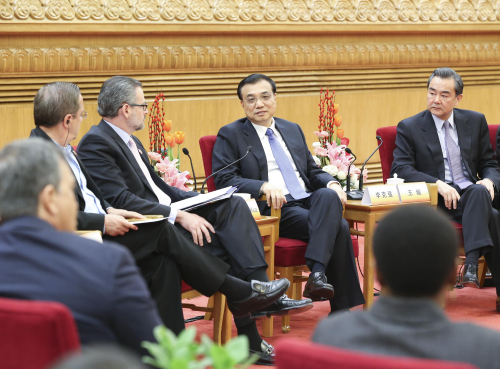|
 |
|
A PROMISING PLATFORM: Chinese Premier Li Keqiang (second right) meets with heads of delegations attending the First Ministerial Meeting of the Forum of China and the Community of Latin American and Caribbean States in Beijing on January 9 (DING LIN) |
Tangible cooperation
Before the Beijing meeting, a report published by the UN Economic Commission for Latin America and the Caribbean said that economic reforms underway in China offer Latin America "a historic opportunity to make a qualitative and quantitative leap forward in its economic and trade relations with the Asian power."
Traditionally, Latin America has provided a vast market for Chinese products and is also a big supplier of raw materials for China's manufacturing sector. At the same time, the high-speed economic growth of China has also pushed up the bulk commodity export of the region, bringing concrete benefits for regional countries. The First Ministerial Meeting of the China-CELAC Forum was held under the theme New Platform, New Starting Point, New Opportunity—Joint Efforts to Promote China-Latin America and the Caribbean Partnership of Comprehensive Cooperation.
This new tendency had first emerged as early as half a year ago. During Xi's last visit to Latin America in July 2014, he proposed building a "1+3+6" cooperation framework between both sides.
Within the framework, bilateral cooperation will be based on the Chinese-Latin American and Caribbean Countries Cooperation Plan (2015-19) and be advanced through three major approaches—trade, investment and financial cooperation. Their priorities focus on six fields including energy and resources, infrastructure construction, agriculture, manufacturing, scientific and technological innovation, and information technology.
The Beijing ministerial meeting has enriched the specific measures of the 2015-19 cooperation plan. The two sides will strive to achieve a trade volume of $500 billion and investment of at least $250 billion within a decade. Cooperation on services, infrastructure, finance, high technology and e-commerce are further emphasized in the plan. Civil aviation authorities and enterprises are encouraged to cooperate more and explore the possibility of increasing flights between China and Latin American countries to expand bilateral exchanges.
Observers noted that besides the traditional cooperation in resources and energy, the other five fields under the "1+3+6" cooperation framework will certainly become new stimuli for future cooperation between the two sides.
Wu with the CICIR predicted that the hi-tech cooperation between China and Latin American countries, which is mainly limited to satellite development and launches at present, will expand. China is reportedly planning to enhance collaboration with Chile on astronomical research and with Argentina on nuclear power development.
Besides the cooperation plan, other cooperation initiatives have also been put forward. The $20-billion special loans for China-Latin America infrastructure cooperation, the $10-billion preferential loans for Latin American countries as well as the $5-billion China-CELAC Cooperation Fund that China promised previously have been in operation or are soon to be launched. The $50-million China-Latin America Infrastructure Cooperation Special Fund has also started to invest in specific projects.
In addition, China has promised 6,000 government scholarships for CELAC members from 2015 to 2019 and will set up Chinese language courses in primary and middle schools in those countries.
According to a declaration adopted at the Beijing meeting, China and CELAC will coordinate on major global issues, and work together on multilateral policy-making with more exchanges between legislatures, governments and youth.
Latin American media and academic circles have shown great interest in the cooperation between the two sides. A recent report by the Venezuela News Agency said that the "1+3+6" cooperation framework has heralded a new chapter in China-CELAC cooperation. It added that the six fields of cooperation and close people-to-people cooperation proposed by China are "specific" and "pragmatic."
In his People's Daily article, García wrote that China and Latin American countries have made remarkable breakthroughs in cooperation on technology transfer and finance.
| 